
Tinder Fungi of Illinois


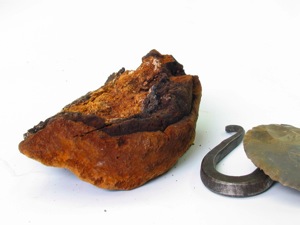

Fomes fomentarius
Phellinus sp.
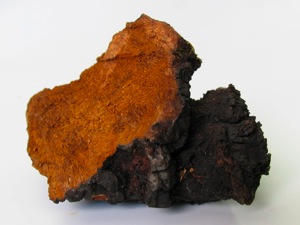

Inonotus obliquus
Long before humans invented matches and cigarette lighters, dried mushrooms played an important role in the creation of fire. Thousands of years ago, people figured out that a tiny spark struck with a piece of iron can ignite the shavings of a dried mushroom--and that bit of smoldering fungus could be used to start a proper fire. We’ve all seen the spark trick: Many iron-rich rocks can create sparks when struck. Rocks are what people used before the Iron Age when people began carrying with them a small piece of steel and flint to create a spark.
Thousands of years later, we still use similar technology: A metal alloy called ferrocerium is what creates sparks in ordinary cigarette lighters.
But why use a fungus?
Most combustible material in nature won’t ignite with a single spark. Yet a few, select species of fungi that can be found on wood have the amazing ability to catch even the tiniest of sparks and begin smoldering--far better than even sawdust, dried leaves, grass, wood shavings or any other tinder found in nature.
Thus, in addition to collecting mushrooms to eat, our ancestors sought out certain mushrooms specifically for creating fires. The 5,300-year-old “Ice Man” discovered in a melting Alpine glacier near the Italian-Austrian border in 1991 had among his possessions two mushrooms, including a tinder fungus (Fomes fomentarius) for starting fires.
Not all species of fungi--and not all tinder fungi--are created equal.
Inonotus obliquus--the True Tinder Fungus--is among the best of all tinder fungi and is prized from Siberia to North America for its ability to ignite with a spark. Another use for Inonotus obliquus is its purported medicinal properties. It’s known as Chaga to people who seek it for antioxidants.
Where can these mushrooms be found?
Fomes fomentarius and Inonotus obliquus can be found on birch trees in the northwoods (the latter also on hop hornbeam trees). In Illinois, a species of Phellinus found on oaks has been used successfully as a good tinder fungus.
But exactly how is a tinder fungus used?
The True Tinder Fungus (as well as the Phellinus species described above) can be dried, then shaved into flecks or scraped into a felt-like fluff (often called amadou) to start a fire with a spark. No special preparation is required. Just strike a spark with flint and steel and watch the tinder fungus begin smoldering. The smoldering bits of dry fungus can then be transferred to a bundle of dried grasses or other tinder to ignite into a proper fire. The False Tinder Fungus, also known as the Horse’s Hoof Fungus, (the species carried by the Ice Man) was reportedly processed into a better tinder fungus by boiling it in ash or saltpeter to increase its flammability.
But there’s more. The use of tinder fungi by humans predates even our ability to create fire. Before people figured out how to make a fire, transporting that source of heat and energy between camps was critical for survival. Once again, mushrooms saved the day. Many polypore mushrooms (those woody, shelf-like mushrooms found on trees) can smolder for hours once ignited. Those chunks of fungi were used to transport fire over long distances.
Again, not all mushrooms are the same. Depending on the species, a piece of dried polypore can smolder perfectly--or it might not smolder at all.
For an experiment, try burning different species of dried polypores you collect in nature. You’ll discover through your experimentation what ancient people figured out long ago: Some species of fungi smolder well, but others seem to be nearly fire resistant. You’ll also discover some fungi have a very pleasing fragrance when burned--similar to incense. In fact, one might literally compare the slow-burning fungus to a slow-burning piece of incense. Our early ancestors, in their quest for fire, would have used incense-like tinder thousands of years before the earliest known evidence of incense use. Is there a connection?
The fact is, the burning of fungi, and the quest for fire, have been a significant part of our human history for thousands of years. And while some prehistoric uses for fungi might now be lost to the ages, the use of tinder fungi clearly influenced the course of human history. Realize that humans are the only species of life on Earth that can create fire on demand, and that red-hot technology has led to an amazing progression of related technologies, for better or worse, including everything from fireworks and ammunition to the generation of electricity and internal combustion engines.
Cooked food represented an astonishing leap forward, not only in diversity for the human diet, but for good health. Cooking food eliminates or destroys many food-borne toxins. When it comes to mushrooms, some mushrooms that cannot be eaten raw become safe and delicious edibles thanks to our mastery of fire.
Think about this the next time you cook mushrooms.
It all began with fungi and fire.





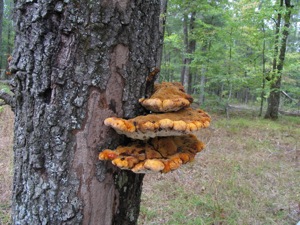

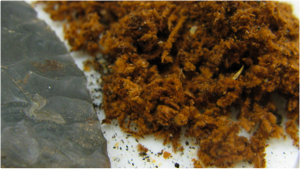
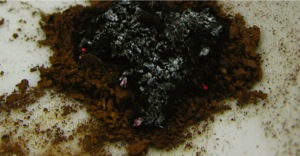



steel and flint



modern incense and burning fungus